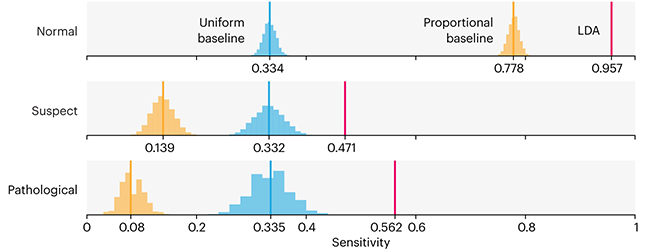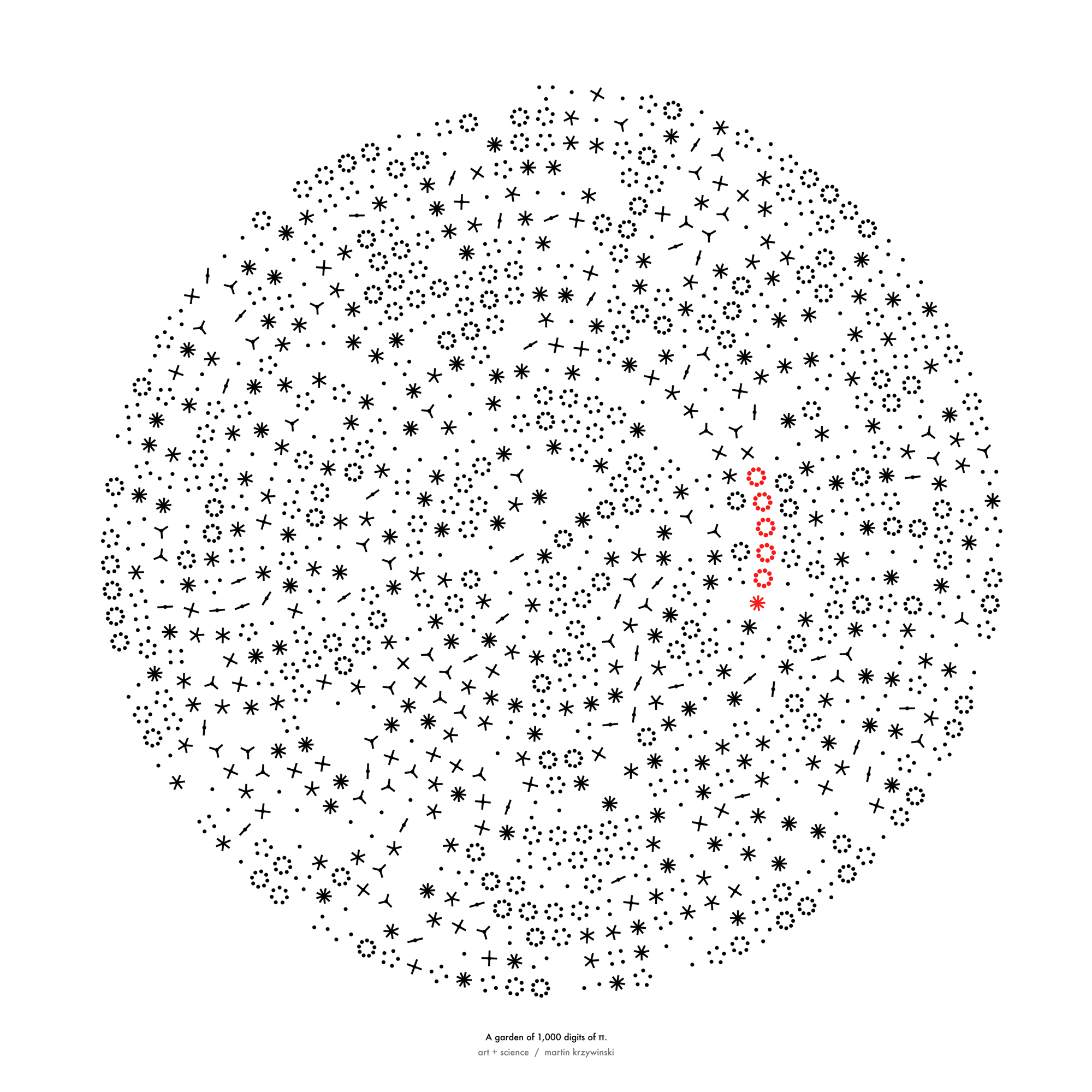Genome Informatics 2010 cover
contents
The program cover shows sequences of some of the genes and viruses that appear in the 2010 Genome Informatics conference's abstracts.


The booklet was published with a black cover background. Below is an inverted and pinkish take on the cover.

Each sequence is represented by a continuous path. The length of the path is proportional to the length of the sequence.
At each point on the path, color is used to show the GC content computed over a window of 20 bases at that position.
Because the GC content doesn't vary greatly, values in the range 0.2–0.6 are mapped onto hues 0–300, with GC values outside that range assigned to the start and end hues. To smooth the color mpaping, a running average is calculated across 10 adjacent samples.
Direction of the curvature of the path is determined by the GC content relative to the average GC content of the human genome.
The magnitude of path curvature is informed by the repeat content near that location, which is calculated by determining the average frequency of 10-mers sampled within a window of 200 bases relative to their frequency in the human exon sequence.
This quantity is expressed relative to the chance of observing these 10-mers randomly and used to inform the angle of the path. Regions that are composed of 10-mers that are relatively rare are straighter than those which contain repetitive regions.

The path is confined within a circular area to keep it compact, at the cost of losing translational and rotational invariance of the representation. This limitation is due to the fact that the segments of the path depend on the angle and position at which the path approaches the circular boundary.
For genes, the transcribed sequence is shown, which includes both introns and exons.

The overall effect of the path encoding is a qualitative, artistic interpretation of local sequence structure. Two paths can be directly compared to interrogate differences in their corresponding sequence.
The Deadly Genomes poster demonstrates how entire genomes appear when encoded as paths. The poster compares the incidence rates and mortality of harmful viruses and bacteria, such as malaria, syphilis, AIDS and SARS.
As on the conference covers, on the poster each genome is drawn as a path. The length of the path is proportional to the size of the genome. Every fifth base is drawn as a circle whose color is based on the GC content (fraction of guanines and cytosines). The path curvature is proportional to the repeat content and the direction of curvature is determined by whether the GC content is lower or higher than average. Genomes are labeled by disease, organism, size (in bases) and GC content. Updated with the genome of SARS-CoV-2 (Wuhan-Hu-1 isolate) and COVID-19 case statistics as of 3 March 2020."

The poster was a finalist in the 2009 National Science Foundation Visualization Challenge.
Nasa to send our human genome discs to the Moon
We'd like to say a ‘cosmic hello’: mathematics, culture, palaeontology, art and science, and ... human genomes.



Comparing classifier performance with baselines
All animals are equal, but some animals are more equal than others. —George Orwell
This month, we will illustrate the importance of establishing a baseline performance level.
Baselines are typically generated independently for each dataset using very simple models. Their role is to set the minimum level of acceptable performance and help with comparing relative improvements in performance of other models.

Unfortunately, baselines are often overlooked and, in the presence of a class imbalance5, must be established with care.
Megahed, F.M, Chen, Y-J., Jones-Farmer, A., Rigdon, S.E., Krzywinski, M. & Altman, N. (2024) Points of significance: Comparing classifier performance with baselines. Nat. Methods 20.
Happy 2024 π Day—
sunflowers ho!
Celebrate π Day (March 14th) and dig into the digit garden. Let's grow something.

How Analyzing Cosmic Nothing Might Explain Everything
Huge empty areas of the universe called voids could help solve the greatest mysteries in the cosmos.
My graphic accompanying How Analyzing Cosmic Nothing Might Explain Everything in the January 2024 issue of Scientific American depicts the entire Universe in a two-page spread — full of nothing.
The graphic uses the latest data from SDSS 12 and is an update to my Superclusters and Voids poster.
Michael Lemonick (editor) explains on the graphic:
“Regions of relatively empty space called cosmic voids are everywhere in the universe, and scientists believe studying their size, shape and spread across the cosmos could help them understand dark matter, dark energy and other big mysteries.
To use voids in this way, astronomers must map these regions in detail—a project that is just beginning.
Shown here are voids discovered by the Sloan Digital Sky Survey (SDSS), along with a selection of 16 previously named voids. Scientists expect voids to be evenly distributed throughout space—the lack of voids in some regions on the globe simply reflects SDSS’s sky coverage.”
voids
Sofia Contarini, Alice Pisani, Nico Hamaus, Federico Marulli Lauro Moscardini & Marco Baldi (2023) Cosmological Constraints from the BOSS DR12 Void Size Function Astrophysical Journal 953:46.
Nico Hamaus, Alice Pisani, Jin-Ah Choi, Guilhem Lavaux, Benjamin D. Wandelt & Jochen Weller (2020) Journal of Cosmology and Astroparticle Physics 2020:023.
Sloan Digital Sky Survey Data Release 12
Alan MacRobert (Sky & Telescope), Paulina Rowicka/Martin Krzywinski (revisions & Microscopium)
Hoffleit & Warren Jr. (1991) The Bright Star Catalog, 5th Revised Edition (Preliminary Version).
H0 = 67.4 km/(Mpc·s), Ωm = 0.315, Ωv = 0.685. Planck collaboration Planck 2018 results. VI. Cosmological parameters (2018).
constellation figures
stars
cosmology
Error in predictor variables
It is the mark of an educated mind to rest satisfied with the degree of precision that the nature of the subject admits and not to seek exactness where only an approximation is possible. —Aristotle
In regression, the predictors are (typically) assumed to have known values that are measured without error.
Practically, however, predictors are often measured with error. This has a profound (but predictable) effect on the estimates of relationships among variables – the so-called “error in variables” problem.

Error in measuring the predictors is often ignored. In this column, we discuss when ignoring this error is harmless and when it can lead to large bias that can leads us to miss important effects.
Altman, N. & Krzywinski, M. (2024) Points of significance: Error in predictor variables. Nat. Methods 20.
Background reading
Altman, N. & Krzywinski, M. (2015) Points of significance: Simple linear regression. Nat. Methods 12:999–1000.
Lever, J., Krzywinski, M. & Altman, N. (2016) Points of significance: Logistic regression. Nat. Methods 13:541–542 (2016).
Das, K., Krzywinski, M. & Altman, N. (2019) Points of significance: Quantile regression. Nat. Methods 16:451–452.
Convolutional neural networks
Nature uses only the longest threads to weave her patterns, so that each small piece of her fabric reveals the organization of the entire tapestry. – Richard Feynman
Following up on our Neural network primer column, this month we explore a different kind of network architecture: a convolutional network.
The convolutional network replaces the hidden layer of a fully connected network (FCN) with one or more filters (a kind of neuron that looks at the input within a narrow window).

Even through convolutional networks have far fewer neurons that an FCN, they can perform substantially better for certain kinds of problems, such as sequence motif detection.
Derry, A., Krzywinski, M & Altman, N. (2023) Points of significance: Convolutional neural networks. Nature Methods 20:1269–1270.
Background reading
Derry, A., Krzywinski, M. & Altman, N. (2023) Points of significance: Neural network primer. Nature Methods 20:165–167.
Lever, J., Krzywinski, M. & Altman, N. (2016) Points of significance: Logistic regression. Nature Methods 13:541–542.




